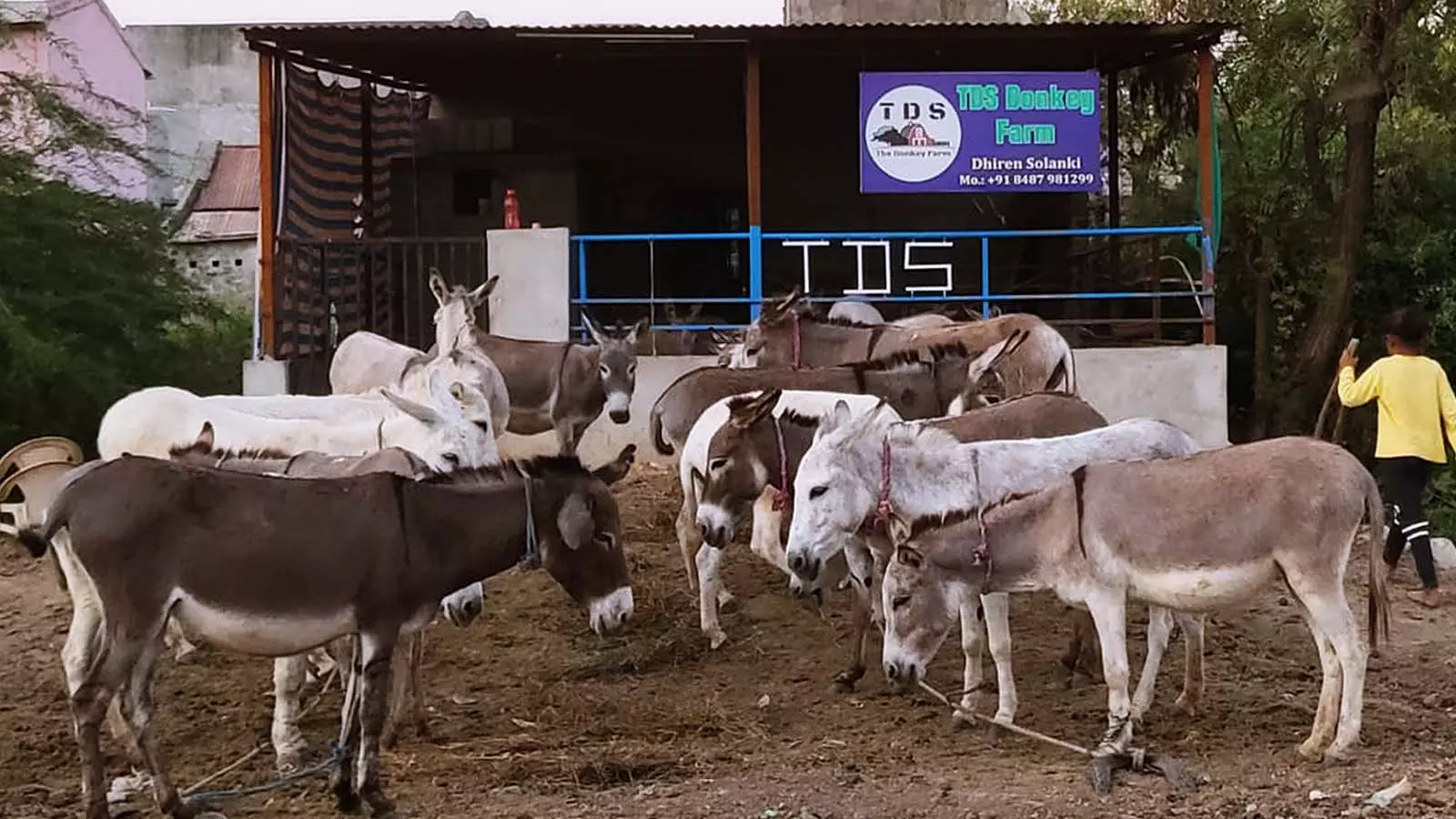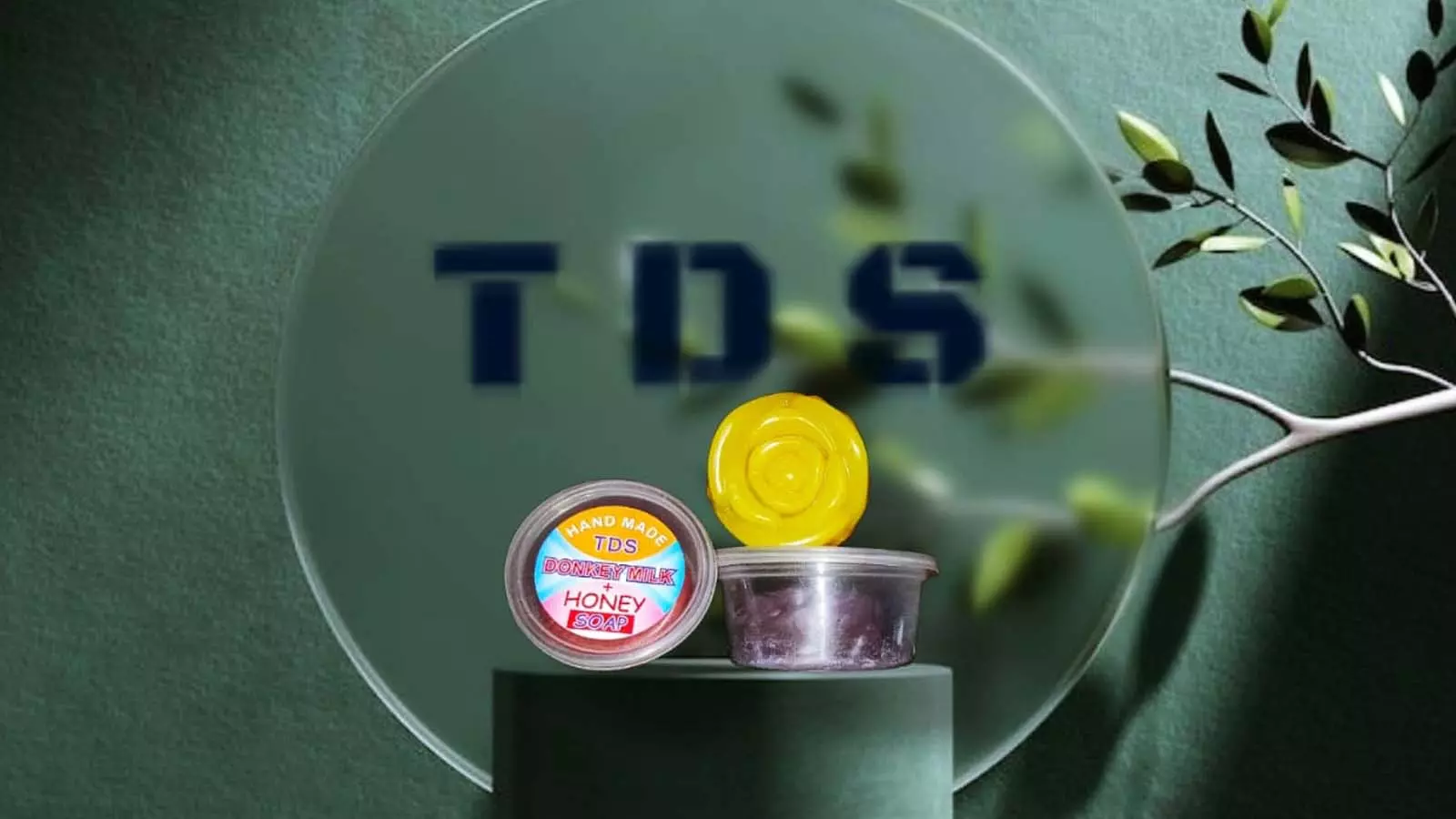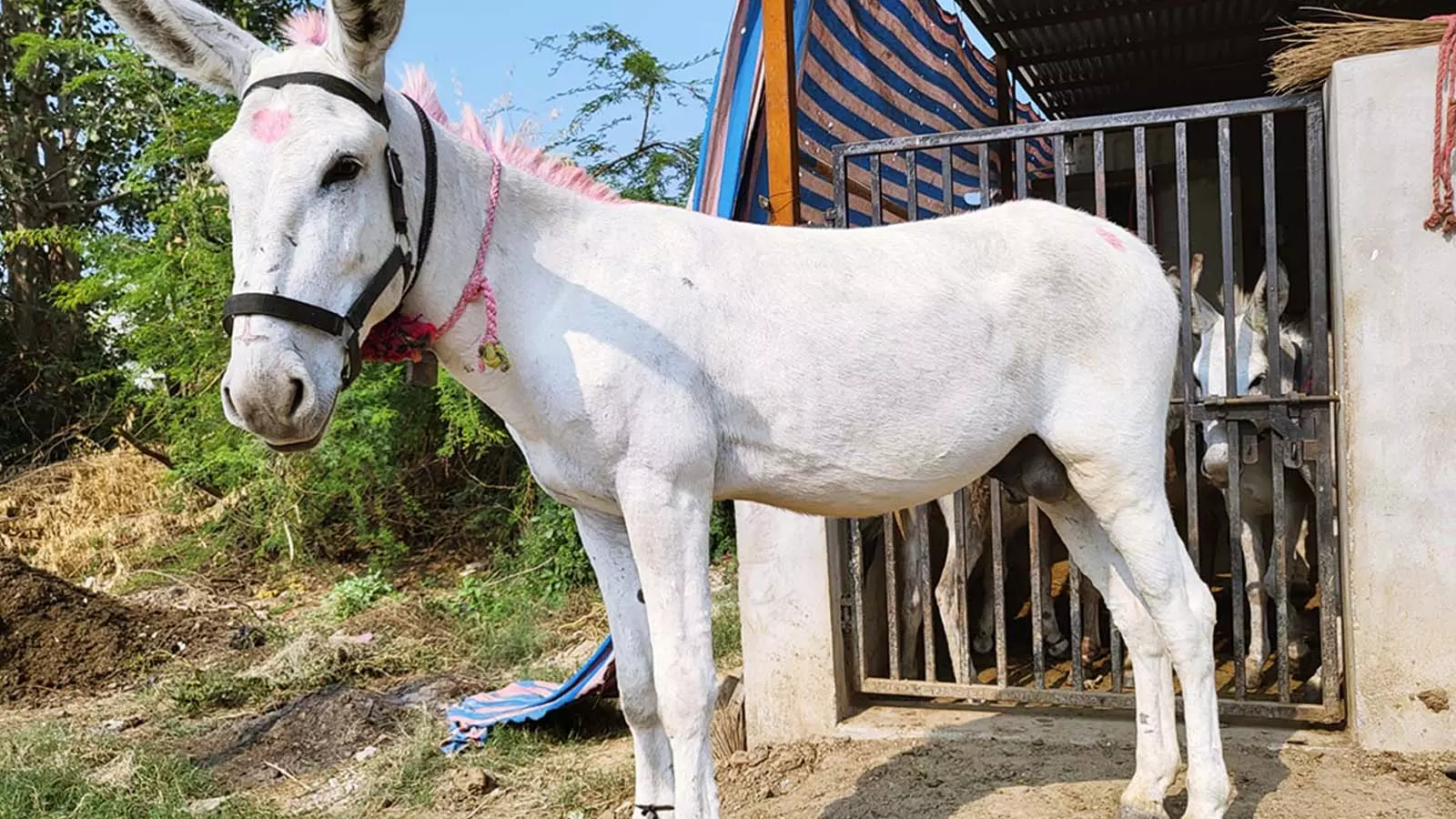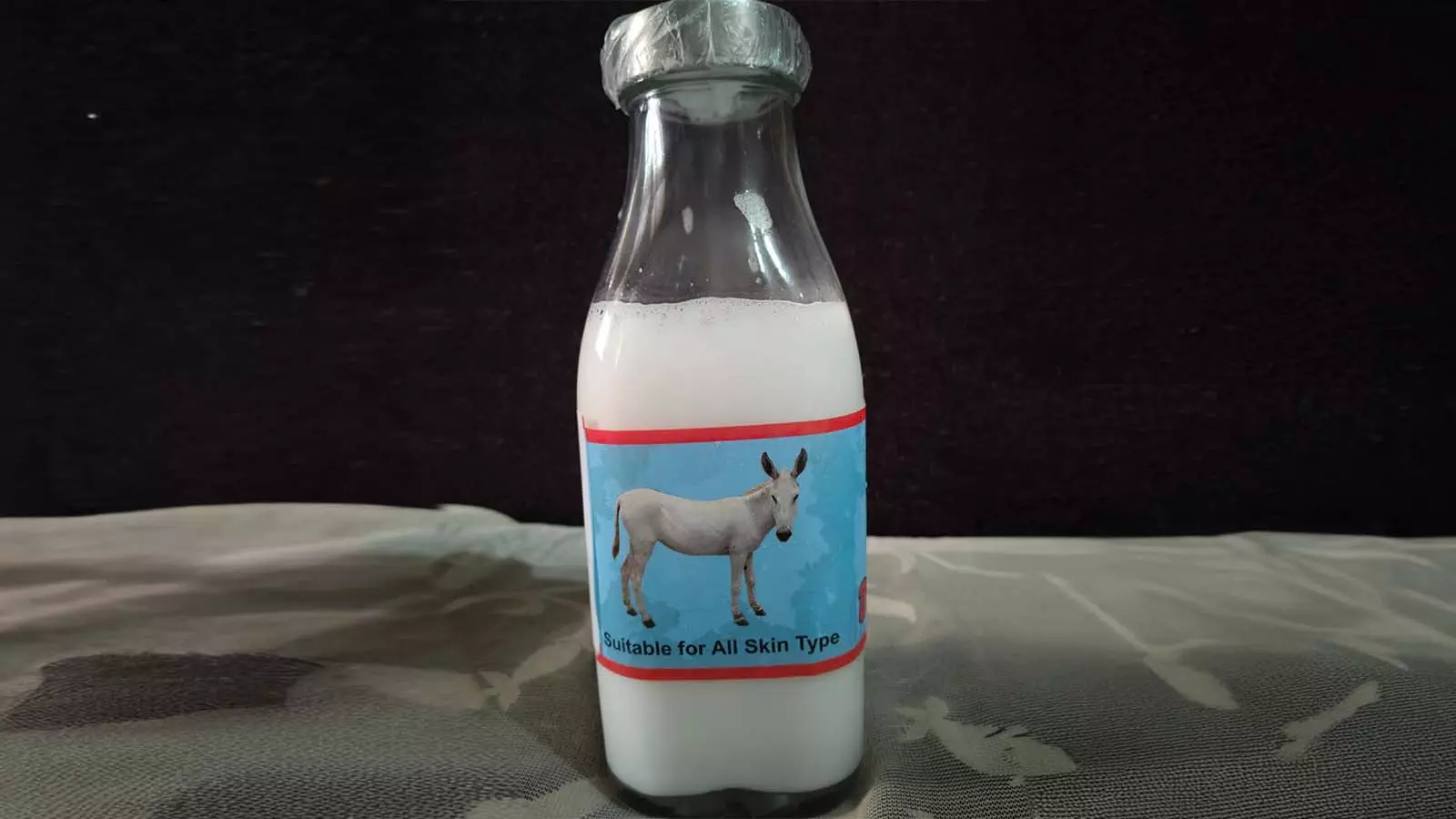
- Home
- India
- World
- Premium
- THE FEDERAL SPECIAL
- Analysis
- States
- Perspective
- Videos
- Sports
- Education
- Entertainment
- Elections
- Features
- Health
- Business
- Series
- In memoriam: Sheikh Mujibur Rahman
- Bishnoi's Men
- NEET TANGLE
- Economy Series
- Earth Day
- Kashmir’s Frozen Turbulence
- India@75
- The legend of Ramjanmabhoomi
- Liberalisation@30
- How to tame a dragon
- Celebrating biodiversity
- Farm Matters
- 50 days of solitude
- Bringing Migrants Home
- Budget 2020
- Jharkhand Votes
- The Federal Investigates
- The Federal Impact
- Vanishing Sand
- Gandhi @ 150
- Andhra Today
- Field report
- Operation Gulmarg
- Pandemic @1 Mn in India
- The Federal Year-End
- The Zero Year
- Science
- Brand studio
- Newsletter
- Elections 2024
- Events
The last Halari donkeys and the young Indian entrepreneur saving them

A research paper on Halari male donkeys by RA Legha, Yash Pal, Vijay Kumar, R. Sachan, RK Dedar, and TR Talluri highlights a sharp decline in India’s equid population over the past three decades. Despite increasing mechanisation, donkeys play a vital role in transporting goods over short distances. They are primarily used by brick kiln owners, potters, shepherds, nomadic herders, and...
A research paper on Halari male donkeys by RA Legha, Yash Pal, Vijay Kumar, R. Sachan, RK Dedar, and TR Talluri highlights a sharp decline in India’s equid population over the past three decades. Despite increasing mechanisation, donkeys play a vital role in transporting goods over short distances. They are primarily used by brick kiln owners, potters, shepherds, nomadic herders, and washermen (dhobis), offering a cost-effective alternative to light transport vehicles. In states like Uttar Pradesh, Rajasthan, Haryana, and Gujarat, donkeys are also employed for carting construction material, food, agricultural produce, and household goods for nomadic communities. Often relied upon by the economically disadvantaged, these animals endure harsh working conditions with minimal care.
Anuradha Bhardwaj from the National Research Centre on Equines, explains in her research paper that donkeys in India have traditionally been used as pack animals and are yet to be officially recognised as dairy animals.
Also read | Why it’s time for bhang stories from Shiva’s chalice
Despite this, donkey milk is gaining attention for its nutraceutical benefits, particularly for infants with multiple allergies, as well as for its use in cosmetic products. Donkey milk differs significantly in composition from more commonly consumed kinds of milk such as cow, buffalo, goat, and sheep milk.
It contains lower fat, casein, phosphate, protein, and inorganic salts but has a higher pH level and lactose content than cow’s milk. The high lactose concentration aids in the intestinal absorption of calcium, which is crucial for bone development and the proper functioning of the nervous system in infants. Circadian studies reveal that lipid and lactose levels peak at night, whereas protein content is higher during the day.
Also read | Why extinction of Toda buffaloes spells extinction of Toda language, culture
Globally, donkey dairy farms have seen a surge in numbers, particularly in Europe, Turkey, and the United States. While this trend is beginning to take root in India, the consumption and commercial use of donkey milk remain relatively uncommon. This key factor prompted 24-year-old entrepreneur Dhiren Solanki to save the critically endangered donkey breed while building a lucrative business—in Patan, the native region of Halari donkeys. Once the capital of Gujarat's Chavda and Chaulukya dynasties in medieval times—Patan, has now grown into a prominent donkey farming hub in Western India. It now has four dedicated farms: Halari Gold Farm managed by Brij Patel, TDS led by Dhiren Solanki, a Horse and Donkey Conservation Farm, which preserves purebred Marwari horses and indigenous donkeys, and NJ Horse and Donkey Farm. However, TDS stands as the largest farm for Halari donkeys and serves as the primary supplier to its counterparts in southern India.

The TDS Donkey farm in Patan.
Dhiren Solanki never planned to become a donkey farmer. Like many young Indians, he was preparing for government employment, a path considered secure and respectable. But when job prospects didn't materialise, Solanki found himself drawn to an unexpected opportunity: establishing a donkey farm focused on the rare Halari breed, native to Gujarat's Halar Pradesh region of Kutch. “I'm not a hardworking person,” Solanki admits with disarming candour at his farm in Manund village in Patan. The COVID-19 pandemic proved to be the unlikely catalyst for Solanki's venture. It is then Solanki delved into researching donkey milk, which had gained attention as a powerful immunity booster.
“It became especially popular in Ayurvedic child care hospitals, where doctors recommend it for its health benefits,” he shares. “In these hospitals, just 2-5 litres of donkey milk is sufficient for daily use. However, it’s hard to come by, and the price is steep. Unlike buffalo milk, which is readily available, donkey milk is rare and expensive.” During this time, his research led him to find out that the scarcity is largely because the critical state of the Halari breed, with only 439 pure-bred animals remaining in India.
Solanki recalls his journey into donkey farming: “The Halari breed originates from my Gujarat, so I began researching it. I soon discovered the unique properties of its milk, particularly during the COVID-19 pandemic when it was reportedly selling for ₹10,000 per litre in Mumbai. Unsure of its authenticity, I delved deeper and realised the breed's significant potential in the pharmaceutical and cosmetic industries. That’s when I decided to start a small farm. Today, I have 150 donkeys, including Halari, Desi, Kathiawadi, and Rajasthani breeds.”

The TDS farm has diversified into value-added products, including soaps prices at ₹270 for 50 grams and ₹530 for 100 grams.
With an initial investment of ₹27 million ($33,000), Solanki established TDS Donkey Farm in 2022, on a 40×30 feet shed, naming it after his wife, Tamanna Dhiren Solanki. Starting with just 20 donkeys, including nine precious Halari breeds, he has since expanded his herd to 150 animals in 18 months. Solanki shares, “The Halari breed is expensive, priced at ₹1.5 lakh for a female and ₹1.7 lakh for a male, which are primarily used for breeding. The milk production comes from the females, while the males are crucial for breeding purposes. For those running breeding centres or working to preserve the breed, the male donkeys are essential. While cross-breeding can produce Halari-like offspring, they won’t be 100% Halari, but rather 20-90% of the breed.”
However, the venture wasn't without challenges. “The biggest problem was finding buyers,” Solanki recalls. In the first eight months, approximately 3,000 litres of milk went to waste before he established reliable market connections. Solanki reflects, “At first, I wasn’t aware that donkey milk could also be converted into a powder form, which can be stored for much longer. While fresh milk can be stored for only a month, the powder can last up to two years. The process involves a freeze-drying unit, typically used for turning food into powder. These units are sourced from foreign companies.”

The Halari breed is expensive, priced at ₹1.5 lakh for a female and ₹1.7 lakh for a male, which are primarily used for breeding.
Despite initial challenges, including a loss of ₹40 lakh due to the milk's low shelf life and limited local demand, Dhiren adapted by targeting markets in southern India. He then expanded his farm to house 45 Halari donkeys, 10.5% of its existing population, and began selling donkey milk online at ₹5,000 per litre, achieving a monthly income of ₹2-3 lakh. Today, his client base spans major cities like Delhi and Mumbai, with products even reaching international markets through exporters to Malaysia. The economics of donkey farming are striking. While conventional cow or buffalo milk sells for ₹60-65 per litre in India, Solanki's donkey milk commands ₹10,000 per litre. The farm has diversified into value-added products, including soaps (₹270 for 50 grams and ₹530 for 100 grams), face creams, night glow cream and milk powder that can be stored for up to two years.
But what led to the decline of the Halari breed, mirrors larger changes in Indian society. “In the past, donkeys were primarily used as hardworking animals, especially in brick factories or places lacking soil, where they were essential for transporting materials,” Solanki explains. “But with the advent of JCBs and tractors, the demand for these animals diminished. This shift led to their decline. People never realised that donkey milk could be valuable, not just for its nutritional benefits but also in cosmetics,” he adds, sharing that he also makes handmade soap from donkey milk, which he sells to skin care doctors and those treating skin infections.
The breeding cycle poses additional challenges. Female donkeys have a 13-14 month gestation period, producing only one foal at a time. It takes approximately 3.5 years for a female to mature and begin producing milk, making population growth a slow process. “In the past, we used to offer training for those interested in starting their own farms, guiding them on how to set up operations and find buyers. If buyers were scarce, we advised them on creating by-products to sell. However, we faced several challenges along the way. This made me decide to stop offering training,” recalls Solanki.
Solanki explains that all business transactions are handled through the website and email, ensuring privacy for the companies involved. “Only I have access to certain details, though others might be curious about doing business. As for pricing, we offer donkey milk at Rs. 500 per litre minimum, and it can go up to ₹10,000 per litre. “If someone wants to order soap, they need to share their details, like address, via WhatsApp. I should mention that this soap isn’t available on a website because I haven’t done lab testing. Handmade soap delivers results, but if it’s made chemically, you won’t see the same readings. However, the result is 100% guaranteed. People often rely on the ratings printed on the back of the product, but I emphasize that the soap works as intended regardless,” he tells me.
Reflecting on the cultural and historical significance of the Halari donkeys in Gujarat, Solanki notes, “While the breed isn’t widely recognised, it holds importance for the Rawal community. There’s a village in Kachchh, Hala Pradesh, where the Halari donkey is considered the village's pride, much like the tiger is to India.” He adds, “In India, only two other people run donkey farms—one in Karnataka and one in Kerala. The one in Karnataka, Srinivas Kavda, turned out to be a fraud. I did business with him, but I was deceived. There’s also a doctor in Kerala, another Kavda, who is our client. Apart from Gujarat, these are the only places where Halari donkeys are bred and farms are established.”
As dawn breaks over his farm in Gujarat's Patan district, Solanki's donkeys— numbered not named—graze freely on the available grassland, tended by four dedicated workers; Poptlal Rawal, Babu Lal, Daya Bhai and Kishan Bhai. Solanki says, “Unlike buffaloes and cows, donkeys don’t require any specific food. Grass is the best for them. On our farm, we don’t even provide additional feed. The workers we have simply milk the donkeys and take the milk away. In some parts of Gujarat, like Patan, there is government-provided land reserved for grazing, where animals can feed freely. There, even with 1,000 animals, there’s enough food available.”

Solanki, who now earns ₹3 lakh per month, represents a new generation of Indian entrepreneurs who are finding innovative ways to preserve traditional breeds while creating sustainable businesses. With an annual turnover of ₹30 million ($35,000), Solanki's enterprise has proven that conservation and commerce can successfully coexist. Solanki notes with pride, “The Halari breed is on the verge of extinction, but thanks to breeding efforts and the establishment of three conservation centres by the government, its population is now steadily growing.”
His farm, spread across three acres, is preparing to double its herd to 300 donkeys. A scene that would have been common across Gujarat decades ago—today, it represents not just the preservation of a threatened breed, but also the evolution of traditional farming into a modern enterprise that could secure the future of Halari donkeys for generations to come.
